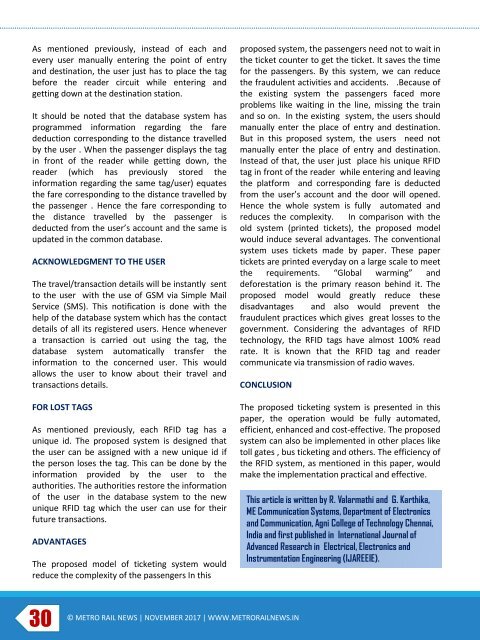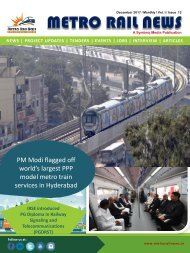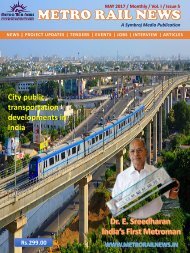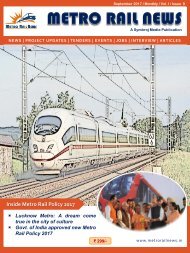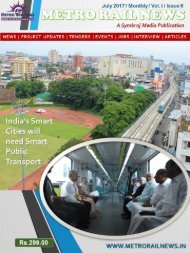Metro Rail News November 2017
Monthly magazine with special focus on Urban Mobility, Metro Rail Projects, Mass Rapid Transit Systems, High Speed Rail Project, Smart Cities Projects etc.
Monthly magazine with special focus on Urban Mobility, Metro Rail Projects, Mass Rapid Transit Systems, High Speed Rail Project, Smart Cities Projects etc.
Create successful ePaper yourself
Turn your PDF publications into a flip-book with our unique Google optimized e-Paper software.
As mentioned previously, instead of each and<br />
every user manually entering the point of entry<br />
and destination, the user just has to place the tag<br />
before the reader circuit while entering and<br />
getting down at the destination station.<br />
It should be noted that the database system has<br />
programmed information regarding the fare<br />
deduction corresponding to the distance travelled<br />
by the user . When the passenger displays the tag<br />
in front of the reader while getting down, the<br />
reader (which has previously stored the<br />
information regarding the same tag/user) equates<br />
the fare corresponding to the distance travelled by<br />
the passenger . Hence the fare corresponding to<br />
the distance travelled by the passenger is<br />
deducted from the user’s account and the same is<br />
updated in the common database.<br />
ACKNOWLEDGMENT TO THE USER<br />
The travel/transaction details will be instantly sent<br />
to the user with the use of GSM via Simple Mail<br />
Service (SMS). This notification is done with the<br />
help of the database system which has the contact<br />
details of all its registered users. Hence whenever<br />
a transaction is carried out using the tag, the<br />
database system automatically transfer the<br />
information to the concerned user. This would<br />
allows the user to know about their travel and<br />
transactions details.<br />
FOR LOST TAGS<br />
As mentioned previously, each RFID tag has a<br />
unique id. The proposed system is designed that<br />
the user can be assigned with a new unique id if<br />
the person loses the tag. This can be done by the<br />
information provided by the user to the<br />
authorities. The authorities restore the information<br />
of the user in the database system to the new<br />
unique RFID tag which the user can use for their<br />
future transactions.<br />
ADVANTAGES<br />
The proposed model of ticketing system would<br />
reduce the complexity of the passengers In this<br />
proposed system, the passengers need not to wait in<br />
the ticket counter to get the ticket. It saves the time<br />
for the passengers. By this system, we can reduce<br />
the fraudulent activities and accidents. .Because of<br />
the existing system the passengers faced more<br />
problems like waiting in the line, missing the train<br />
and so on. In the existing system, the users should<br />
manually enter the place of entry and destination.<br />
But in this proposed system, the users need not<br />
manually enter the place of entry and destination.<br />
Instead of that, the user just place his unique RFID<br />
tag in front of the reader while entering and leaving<br />
the platform and corresponding fare is deducted<br />
from the user’s account and the door will opened.<br />
Hence the whole system is fully automated and<br />
reduces the complexity. In comparison with the<br />
old system (printed tickets), the proposed model<br />
would induce several advantages. The conventional<br />
system uses tickets made by paper. These paper<br />
tickets are printed everyday on a large scale to meet<br />
the requirements. “Global warming” and<br />
deforestation is the primary reason behind it. The<br />
proposed model would greatly reduce these<br />
disadvantages and also would prevent the<br />
fraudulent practices which gives great losses to the<br />
government. Considering the advantages of RFID<br />
technology, the RFID tags have almost 100% read<br />
rate. It is known that the RFID tag and reader<br />
communicate via transmission of radio waves.<br />
CONCLUSION<br />
The proposed ticketing system is presented in this<br />
paper, the operation would be fully automated,<br />
efficient, enhanced and cost-effective. The proposed<br />
system can also be implemented in other places like<br />
toll gates , bus ticketing and others. The efficiency of<br />
the RFID system, as mentioned in this paper, would<br />
make the implementation practical and effective.<br />
This article is written by R. Valarmathi and G. Karthika,<br />
ME Communication Systems, Department of Electronics<br />
and Communication, Agni College of Technology Chennai,<br />
India and first published in International Journal of<br />
Advanced Research in Electrical, Electronics and<br />
Instrumentation Engineering (IJAREEIE).<br />
30<br />
© METRO RAIL NEWS | NOVEMBER <strong>2017</strong> | WWW.METRORAILNEWS.IN


